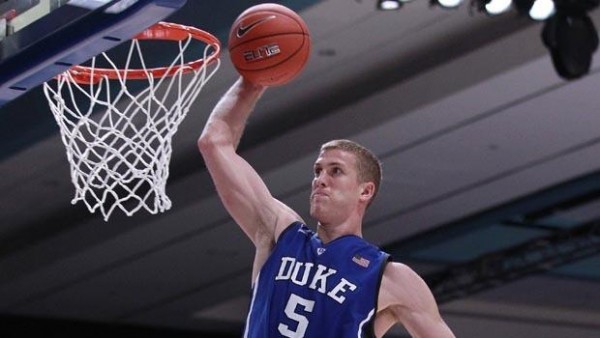From Punching Bag to Prize Fighter: Mason Plumlee’s Journey to the NBA
Posted by mpatton on April 24th, 2013When he arrived at Duke, Mason Plumlee — despite his obvious upside — was actually ranked below teammate Ryan Kelly, according to the Recruiting Services Consensus Index. Kelly was ranked #14 in the class, while Plumlee was #18. Even more fascinating to look back at are Plumlee’s Draft Express archives. Coming out of his first season at Duke, the scouting service looked for Plumlee to continue to develop as a stretch four! To be fair, he did hit 21 threes in 38 games in his prep senior season (unfortunately his shooting percentage is unavailable), but Plumlee’s transformation from a flat-shooting, athletic, potential-stretch four to one of the premier post players in college basketball is a compelling story.
During his freshman year Plumlee was buried behind Brian Zoubek, Lance Thomas and older brother Miles Plumlee. He still contributed significant minutes to the 2010 national championship team, but he was raw in the purest sense of the word. His sophomore efficiency profile, with two glaring exceptions, actually started looking a lot like the NPOY candidate we saw this year. The two massive improvements Plumlee made since that season were in terms of volume and taking care of the basketball. But obviously, the numbers don’t tell the whole story. Mason Plumlee was a very different player as a senior than he was as a sophomore.
This year Duke ran its offense through him in the post — even Duke’s possessions where he didn’t get touches were influenced by his presence. Unlike the previous three years, Plumlee excelled at finding good post position during his senior campaign. He still relied on the backcourt to get him the ball, and the replacement of Austin Rivers with Rasheed Sulaimon was instrumental on that front. However, unlike previous years, Plumlee sought out the low block where his limited post game led by his trademark line drive hook shot, proved very effective without needing an elite point guard to find him open dunks.
The second big change was his attitude on the floor. Plumlee was still good for at least one head-scratching foul and/or turnover a game, but he oozed a confidence everywhere else but the free throw line that depleted his dead-end possessions from past years. Plumlee drastically reduced his power dribbles and second-guess pump fakes, instead choosing to take more contact and use his size and strength to his advantage. Here’s where the Duke coaching staff should be lauded. It’s also why returning to school after his junior year was absolutely the best call for Plumlee. NBA teams don’t have the time or personnel to develop a player’s confidence. They can remake a player’s shot (and maybe get rid of that wavy hitch that leads to his horrid jumper) and teach new post moves, but that supreme level of confidence has to be there going into the league. Plumlee won’t be a star at the next level, but the development of faith in his abilities at Duke gives him a much better chance at sticking around the league for the long haul instead of washing out with his rookie contract. Duke and Mason Plumlee were both better off because he came back for his senior season. He achieved the success many expected early in his career by playing to his strengths, even if those strengths were of the type nobody would have predicted at the time.










































